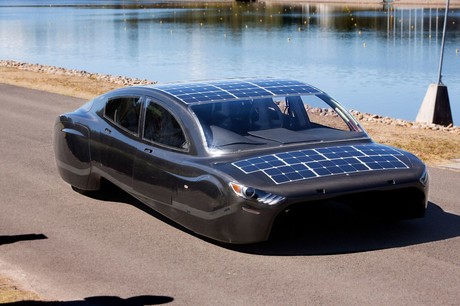UNSW team to attempt to break their own world record in solar car

Sunswift Violet, a four-seat sedan designed and built by engineering students at UNSW, left Sydney on Wednesday on a 4300 km drive to Darwin, where it will compete in the Bridgestone World Solar Challenge.
It is the sixth-generation solar car created by the UNSW Solar Racing Team Sunswift, built for practicality, speed and endurance, combining cutting-edge technology with modern comfort.
Sunswift Violet will be battling 47 teams from 21 nations in the 3021 km race from Darwin to Adelaide which begins on Sunday, 8 October 2017.
“Violet looks like a family sedan but uses as much power as a four-slice toaster,” said Sunswift team leader Simba Kuestler. “She’s got entertainment and air-conditioning systems, including navigation, reverse-camera parking sensors, and there’s even Wi-Fi aboard. And she’s got plenty of front and rear boot space.”
It has a top speed of 130 km/h and a range of 800 km running just on its rooftop solar panels. It also sports modular lithium-ion batteries which store power from the sun; running just on its batteries, it has a range of 400 km. The vehicle relies on around 7 kW of horsepower at 110 km/h, and two 1.5 kW motors that run at 98% efficiency.
With a twill carbon-fibre monocoque chassis, Sunswift Violet weighs in at less than 400 kg. And because good aerodynamics are vital in the quest for energy efficiency — the more slippery the car, the better — Sunswift Violet has a drag coefficient below 0.2, better than the best wind-cheating cars on the market.
While undergoing race testing at the Sydney Motorsport speedway in Eastern Creek late last week, the car experienced a mishap: a bolt on the left-hand front suspension fractured during intense speed braking tests, causing the car to drop onto the roadway and skid for some 30 m. There were four students aboard at the time, but no-one was hurt.
Mark Hoffman, UNSW’s Dean of Engineering, said challenges like these are a learning opportunity: “The car is operating at the cutting edge of what’s possible, and the students [are] putting it through strenuous testing ahead of a race where they will face intense conditions, so it’s no surprise they will face setbacks,” he said. “That’s what an engineering degree should be about — learning about demanding, real-world challenges.”
Despite the setback, the team of undergraduate students worked late nights and over the weekend to repair the damage and reinforce all the dynamic systems of the car, in order meet their original schedule.
The Sunswift team holds the world land-speed record for an electric vehicle, recognised in 2014 by the Fédération Internationale de l’Automobile, when their previous vehicle — Sunswift eVe — travelled at an average 100 km/h over a distance of 500 km on a single charge. This broke a record that had stood for 26 years, and was recognised with a world record trophy.
Teams competing in this year’s Bridgestone World Solar Challenge come from Belgium, Canada, Chile, Germany, Hong Kong, India, Iran, Japan, Malaysia, the Netherlands, Poland, Singapore, South Africa, South Korea, Sweden, Taiwan, Thailand, Turkey, the United Kingdom and the United States, as well as Australia.
Mars Wrigley to boost Asquith factory with new production line
Mars Wrigley Australia is installing a new production line at its Asquith factory to boost...
Welding body calls for a nation-building approach to combat Trump's tariffs
Weld Australia believes that US tariffs offer Australia a unique opportunity to carve out a new...
New free TAFE courses aim to develop manufacturing skills
The NSW Government has announced four new free TAFE courses designed to upskill Australians and...








